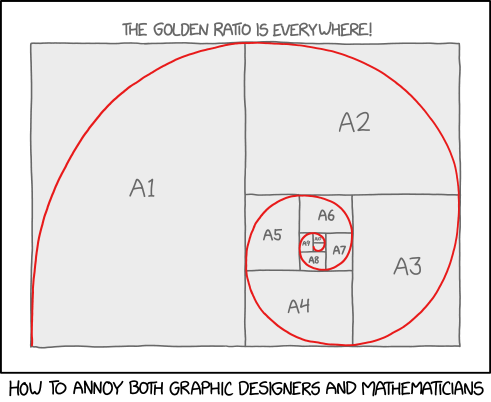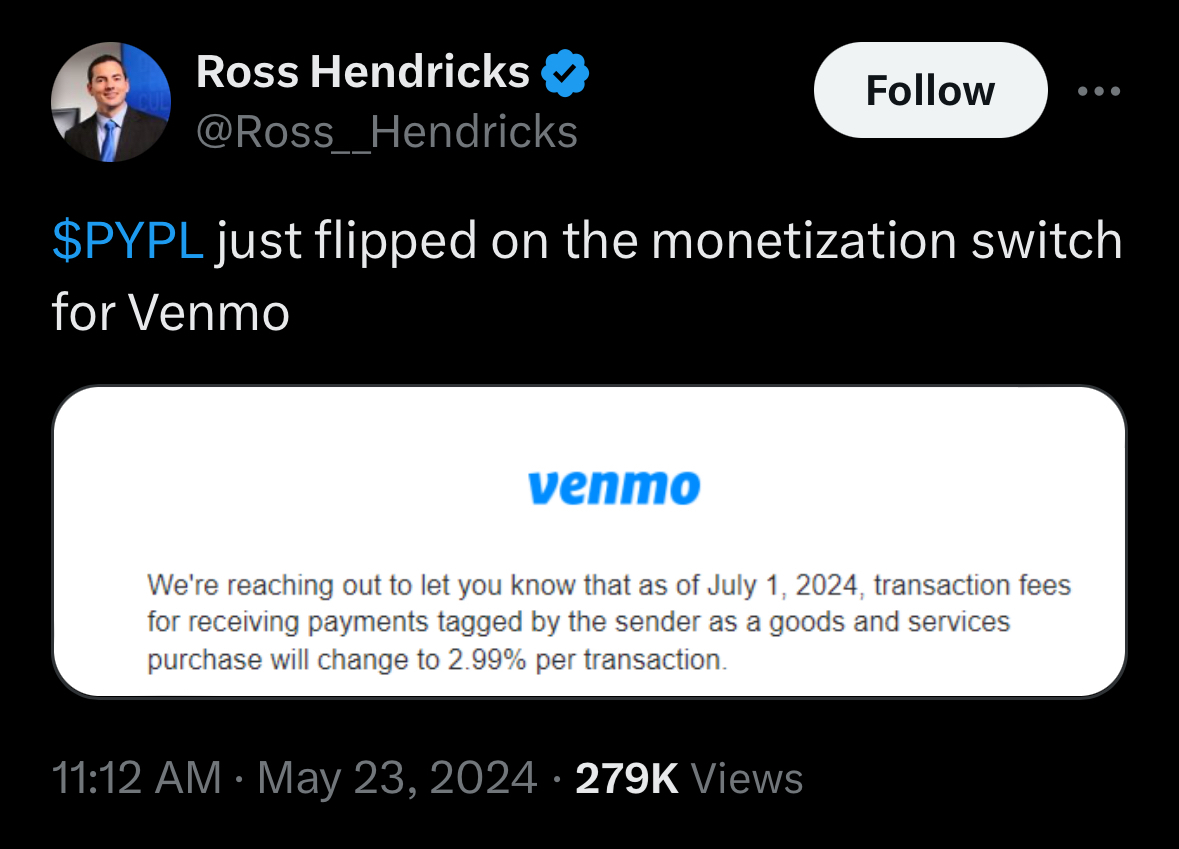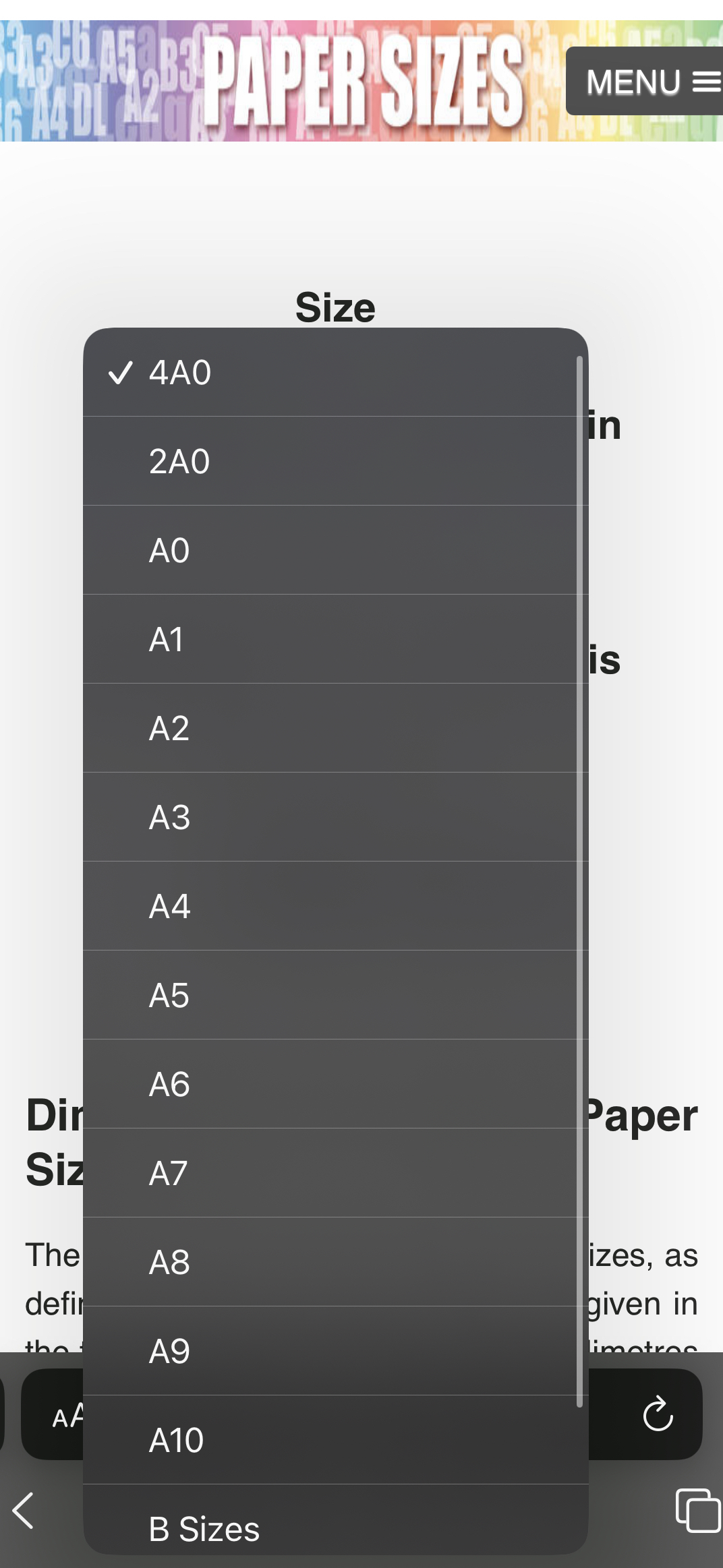alt-text
It blows our hivemind that the United States doesn’t use the ISO 216 paper size standard (A4, A5 and the gang).
Like, we consider ourselves worldly people and are aware of America’s little idiosyncrasies like mass incarceration, the widespread availability of assault weapons and not being able to transfer money via your banking app, but come on - look how absolutely great it is to be European:
The American mind cannot comprehend this diagram
[Diagram of paper sizes as listed below]
ISO 216 A series papers formats
AO
A1
A3
A5
A7
A6
Et.
A4
Instead, Americans prostrate themselves to bizarrely-named paper types of seemingly random size: Letter, Legal, Tabloid (Ledger) and all other types of sordid nonsense. We’re not even going to include a picture because this is a family-friendly finance blog.
As a math nerd, I appreciate the fractaline nature of your paper.
But as an american, what is the practical advantage?? The sizes are so far apart, and you dont get papers with different ratios? Like for example Letter and Legal are both 8.5 inches wide, can be used in any standard cheap household printer, legal is just longer so you can fit more stuff on the page. Letter paper folds into thirds to fit snuggly in an envelope and legal folds into fourths. Other paper sizes are so niche and rarely used why does it matter if theyre a perfect mathematical ratio or not?
Commercial printers will print most everything on A0 paper, but since all metric paper is doubling or halving sizes with respect to each other, they can tile a bunch of print jobs into the same A0 paper and then cut them apart, saving machine time by turning a bunch of small jobs into one big job.
US printers also do this, just using larger ANSI sizes instead of larger A sizes. Or they just use rolls.
But US paper sizes don’t tile nearly as well as metric paper sizes do, is the point
The advantage is folding.
When folded at the middle it becomes the next size.
So if you have an A4 paper but don’t have the proper C4 envelope, you can fold the paper in half and put it in a C5 envelope. This is standard.
Let’s then imagine that you don’t have a C5 envelope either, but only have the remaining Christmas card envelopes, which are C6. So you just fold your paper one more time at the middle and it’ll fit again.
Also, the area of A0 is 1 square meter. You probably don’t nornally have an A0 paper around, but that doesn’t matter, because you can take 8 pieces of A3 or 16 pieces of A4 papers, tape them together and it’ll be A0.
Now it isn’t actually a square meter. It’s the same area, but it’s not square. No, the length and width makes the golden fucking ratio. This might be irrelevant for a legal document, but it’s pretty neat if you want to make a nice drawing.
Paper come in reams. Reams come in boxes. Boxes come on pallets. The paper boxes fit perfectly on a pallet in both length and width, so the layers of boxes can be placed either way in an interlocked pattern. This is mostly a ix design thing though. American paper also fit on American pallets, but without the connection through the sizes, you cannot make a pallet with mixed sizes and expect it to fit.
Isn’t the ratio of length and width of A-papers square root of 2 and not the golden ratio?

Correct. A piece of paper with the golden (aspect) ratio would have the property that if you remove the large square (with side length equal to the shortest side of the rectangle) then the remaining rectangle has the same (golden) aspect ratio.
The ISO216 ratio of 1:sqrt(2) has the property that if you cut the paper in half then both halves have the same aspect ratio as the original larger piece.
People tend to confuse these two properties as they both involve the remaining rectangle having the same aspect ratio as the original piece, but the process to bisect the sheet is different.
But that’s not something i have ever actually needed.
You say that, but you pay a premium for these things to be generally less efficient. Why waste?
Well, more efficient packaging and shipping is a pretty good goal in general. Although what’s better is just…not having to ship pallets of paper around, it’s 20 fucking 24.
Limitless paper in a paperless world
Scalability. You can design something in A3/A4 and if you want the page in a smaller, common format, you can print it as A4/A5. This is especially handy for designing flyers, or scaling bigger stuff (like schematics, which are usually drawn on A1/A2) down to print it on household printers.
It’s also quite convenient that pretty much anyone has a common understading of what A3/A4/A5/A6 is, when talking about areas in real life.
Also, if you need A5 put only have A4 paper, you can cut it or even split it without scissors. That usually even gets better results, because splitting a piece of paper in two by folding is easier to do precisely that to do it whith scissors.
Making a page longer just to “fit more stuff on it” isnwt really such a great boon, since you always need a cut-off somewhere.
A4 can be folded into thirds as well and smaller envelopes are perfect for A6.
It’s also quite convenient that pretty much anyone has a common understading of what A3/A4/A5/A6 is, when talking about areas in real life.
We know “the size of a sheet of printer paper” and also that size when “folded hot dog” or “folded hamburger”.
Y’all can’t fold ‘em fish ‘n’ chips, ever heard any food terms used to refer to length/wide folding?
yeah, this is a great thing!
i usually make class notes recap on A4 pages, and can then print 2 A5-sized pages side by side on a single standard A4 paper, no need to rework the formatting. messing with the printer options, you can pretty easily get it to do a small booklet off of your standard A4 word document, just need to staple it together!
Just use multiple pages if needed?
Who needs all their words on a single huge page like some sort of scroll?
It takes less paper to print 1 page of legal if that’s what your text fits on than it does 2 pages of normal paper if said text doesn’t take up all of the second piece of paper.
When you’re printing large documents (10 or more pages let’s say) that starts to be significant savings in thickness of a stack, too.
It’s not one huge page, it’s an extra 2 inches, or ~25% longer
do they go down to A -1, A -2 and so on
Not officially, but unofficially there’s 2A0, 4A0 and so on. Bigger than that is rarely used however.
No just A0, A1, etc. A5 being for cards, A4 being the average used in schoolbooks and such, with A3 mainly used for posters, never seen anything larger in everyday life.
Ad posters on the street are usually A2 to A0
Eh, letter’s height to width ratio looks better.
Wait a second if the bank app can’t transfer money how do they do it? Just barter with guns? Are the bullets like coins?
We have a fee-free bank-to-bank transfer system that is based on pre-digital technology that takes 2-3 business days. We often call it “direct deposit” or automated clearing house (ACH). It’s often used for payroll and paying bills.
Now, we could probably make this payment system instantaneous relatively effortlessly (and thus useful for regular in-store purchases), but the banks lobby against this so they can continue to charge us fees and interest to over-use credit cards. (Interestingly enough, credit and debit cards all use direct deposit on the backend to actual transfer funds between parties).
This is all fine and dandy for most people because they simply can’t imagine doing things a more consumer-friendly way.
Your comment is all true, except - we CAN all imagine it, but as you pointed out, our unchecked hyper capitalism prevents it
We have a fee-free bank-to-bank transfer system that is based on pre-digital technology that takes 2-3 business days. We often call it “direct deposit” or automated clearing house (ACH).
Ah, right, kinda like SEPA Credit Transfer. You do need a persons IBAN which is a bit long, but their name is validated so you usually send it to the right person.
Now, we could probably make this payment system instantaneous relatively effortlessly
Ooh, cool, kinda like SEPA Instant Credit Transfer, which transfers money within ten seconds to bank accounts using the above mentioned number.
This is all fine and dandy for most people because they simply can’t imagine doing things a more consumer-friendly way
And that’s why, in the Netherlands, Tikkie took the country by storm. It is an app that allows you to use iDEAL (a web-based payment system, soon rolled out in Germany and Belgium as Vero) to send money to friends. Usually takes one pin and three taps to send it, and have it instantly appear on the account of the recipient.
I imagine it has also something to do with safety? Like, if it was instantaneous, that means you can do damage instantaneously, or a hacker might have fewer hurdles to go through.
Actually, a lot of banking apps can be used to transfer money now, it’s just done through Zelle. We can also do a bank transfer using the routing and account number (at least with my banking app) but that I think takes longer.
i just assumed people used 3rd party services for ease of use or faster transactions, seems so wild that you’d not be able to send money using your bank to me
here it takes 1-2 business day for a free wire transfer from one bank account to another, and you can do it in your banking app or on the bank’s website. you just need to authenticate with your online pin code. you can also pay 1€ to get a <24h transfer
it’s honestly much better than using a third party service, since pretty much everyone has a bank account, and pays using a card tied to that account directly
Brasil enters the chat
No fees transfer takes seconds, as long as it’s not international. People use it for buying groceries, clothes or paying for whatever they buy in the middle of the street from other people who are not businesses. Confirmation of payment from receivers end is immediate with a push on your phone.
All sellers can produce a QR code including receiver address and price to be payed. All bank apps scan and pay seamlessly.
Quite similar to India’s UPI system
Russia enters the chat.
Same. It is done with National Payment System of Cards law, which people usually call “MIR cards”. It started as replacement system for visa and mastercard, but evolved into System of Fast Payments/Transactions.
You can use it in three ways: enter recepient’s card number, enter recepient’s phone number or use qr code.
In Canada we have Interact e-Transfer. Basically all the banks colluded to make a system that allows for instant money transfer between banks using email or phone number as the recipient identifier, along with options for comments and security questions.
I felt like this was a huge step up compared to all the hoops and third party apps I had to use in Europe.
huh, yeah, i heard of similar things in the US
here it seems to be worked out through legislation though, rather than private deals, but that means it’s much slower to get set in place
Idk what all this talk is about - we have wire transfers in the US. I don’t need a third party to do it either, it’s exactly as you’ve described, I can do one through the bank’s app or on their website, and it’s free. It’s not as common though since the information required is: Name of the recipient’s account exactly as it is, account #, routing #, and exact name of the bank tied to the routing #. You can save that info though to make it easier to transfer the next time around - it’s very useful for close family and friends.
and it’s free
This is very uncommon in the US. Most major banks (I’m not aware of any exceptions) charge a fee for each outgoing wire transfer, usually $25-$30. Bank of America, Wells Fargo, Chase, and PNC for just a few examples I’m aware of, plus every credit union that has local branches in my area. Some of those banks even add a second fee at the recipient’s side for incoming wire transfer.
They often encourage customers to rely on third party services like Zelle instead for small transfers to friends and family. Many banks’ sites/apps can also handle transfers between two accounts that both belong to the same bank for free too.
SEPA is not to take for granted.
Isn’t sepa the eu system?
Sorry but bank transfers are not 1st world exclusive, it’s common place in 3rd world as well.
We involve third parties to help spy on our transactions.

It’s OK, they charge us for the privilege.

Wtf?
Also are banks just dumb or what? Has it crossed their greedy minds that they also can charge to make transfers?
What’s pictured there is when people use Venmo to pay for something instead of just transferring money between friends. The fee is paid by the seller. Banks already do this for traditional sellers in the US which is why you’ll see signs asking for cash instead of cards.
And tax evasion. But I don’t care as long as the tamales are good.
Do Visa, Mastercard, etc, not charge transaction fees in Europe? The only place I’ve been where there’s no transaction fees paid by the vendor is China.
I owned a business in Europe. My bank charged me a pretty low monthly flat fee for card charges, so I would take cards for any amount.
I’m in Australia and it’s a mix. Some places add the surcharge to the bill and can use cc for as low as$1, some don’t and don’t accept payments that’s less than 2 people’s meals ( and also don’t accept split bills).
But it’s very very hard to find a place that’s cash only. It comes to mind empanadas, so I got a laugh at the other reply about tamales.
Venmo, Zelle, Cash app, etc.
My last 3 banks all had ACH transfers in-app, too, so idk what they’re smoking
ACH transfer to a friend’s bank account?
I assume it’s ACH, I’m at work and my job includes doing ACH work so that just kinda typed out.
It has me put their routing and account number in, then took anywhere from 5 minutes to a day to clear, p sure that’s ACH
Wow awesome!
A day isn’t cool, but five minutes is pretty much acceptable.
I’m in Aus and our transfers are usually instant. However if you’re transferring a couple hundred bucks or more, and you haven’t made a transfer before to a person, it will hold it for a day. I think to give the customer time to call and say the transfer was fraudulent.
I pay monthly rent in Australia with that, couple thousands and no big deal
I respect that!
And the ACH only takes three business days!
3 days? UK here, the other day I transferred money to my wife (different bank) while she was handing her card to the cashier at the supermarket. It took about 1 second.
Surely there’s some challenger bank letting you do modern stuff?
Hahaha! We don’t have fair competition in America, silly!
Yeah they’re just making shit up, and it’s anti American so Lemmy assumes it’s true.
idk why the image says “european”, the standard is worldwide. only north america and parts of latin america don’t use it afaik.
I know Brazil uses the A# format, dunno about other latin countries.
A Sharp?
no A-Hashtag you dummy
A-pound
nah that wpuld be A-£
Nah you mean A-lbs
AOctothorpe
Extra painful papercuts
Japan also has their own system.
Japanese use JIS but A size is the same with ISO so there’s no confusion here. For B size there’s slight difference in JIS and ISO, but as end user I hardly print anything other than A4 so haven’t encountered problems myself.
Damn, you beat me to it.
Here is an alternative Piped link(s):
Piped is a privacy-respecting open-source alternative frontend to YouTube.
I’m open-source; check me out at GitHub.
Lol, people find the silliest things to be angry and indignant about.
Found the American.
What an idiotic thing to say in a comment to a post not written by an American, that’s complaining about Americans.
Sorry, ya lost me there, huh?
There are easier ways to find us! (get a map, ask strangers to point at anywhere but North America; the first incorrect answer or anger response will probably be one of us)
I guess someone never used ISO 216.
Wait… You can’t transfer money with a banking App???
Zelle is a thing with my banking app.
My sister has a credit union bank account and her app has it. I have PNC.
Yes. I can transfer money to someone just by knowing their phone number. I can do it on a Sunday afternoon and they get the money instantly. I haven’t used cash for more than a decade now. Haven’t used a card for at least 5 years.
I’ve been able to transfer money through my banking app for a while without issue. Not sure where that came from in the post, cause it’s not true lol.
Not really sure about that one, I’ve been able to transfer money with my banks app for more than a decade. Not all US banks are created equal.
Not all US banks are created equal
I think that’s the issue. Also how common direct deposit for paycheques in the US? I hear it’s rare but in Canada, it’s the norm and all our banks here can do e-transfers.
I’ve had direct deposit for every job since around 2004, before that it was a paper check on payday. Really I signed up for direct deposit after my manager gave me a hard time when I came in to pick up my check on a day I called out sick.
It’s relatively common, unless you work for a typical cash pay job (usually labor jobs, like construction)
I’ve had direct deposit at every job I’ve worked for over a decade. Before then, I only had one job that didn’t offer it, though I had friends with jobs that did have direct deposit. Very common to have it these days. Some jobs can even get you direct deposit for the amount you worked that very same day, so I’d work 8 hours and by the time I get home, I’d have my pay from that day, and it’s like that everyday.
Source: US citizen
Aside from the 1 to √2 ratio, the area of A0 paper is exactly 1m². People behind ISO 216 thought of everyting.
Which is awesome, because every number up halves the size. This, combined with the standard way that paper weights are given (e g. 80g/m2) allows you to easily calculate how much a piece of paper weights: 1 A4 80g/m2 weighs 5g (1/2^4 * 80g)
Now it makes even more sense!
From their website: “We’re ISO, the International Organization for Standardization. We develop and publish International Standards.”
Sadly, ISO in recent decade started to do bullshit. They don’t pay for standard development, they don’t employ anyone for standard development, they collect membership fees from national standards organizations, require payment to download most standards and don’t allow to copy published standards. Also they retroactively paywalled a lot of standards.
People behind ISO 216 thought of everyting
how to make a good standard:
step 1: copy from DIN
Well, Germans are pretty anal about standards (thankfully) and they do them right, so why not copy them?
so why not copy them?
oh, I totally agree with you.
In fact standards are made to be copied. That’s like the entire point of them.
The world would be a better place if we copied good things more often.
Imagine all of Europe copied Dutch transportation-, German prostitution- and Portugese drug-policies
fun fact: the length to width ratio of ISO 216, √2:1, is the same ratio as the tritone in an equal tempered 12-tone musical scale. If you fold A4 paper in half, you get a piece of paper with the same length to width ratio as before; analogously, if you invert a tritone, you get another tritone.
But is it a diminished fifth or augmented fourth?
Ackchyually…
As famously read from letter-sized sheets:

I know it should be a fun fact but I can’t quite grasp it.
That is fun!
PC LOAD LETTER? the fuck does that mean!?
It means there is a tiny scrap of paper lodged in one of the uptake wheels in the paper tray.
My country (not USA) uses American paper. I hate it.
What the fuck, that was way more hilarious than a blog post about financial securities messaging ought to have been
It’s a beautiful standard that works wonderfully until you have to deal with any actual measurements. 210 x 297 mm - so easy to remember and divide.
Letter is 215.9mm x 279.4mm lmao
Excuse me, I believe you meant to say:
215 57/64mm x 279 38/96 mm
Good thing Americans don’t use metric, that sure would be an awkward size.
No it’s 8.5 by 11.
See? Easy. Also you really have to try to get your hands on something that’s a different size. 99 percent of printer paper is Letter.
8.5" is not any easier to divide than 297mm. Try dividing 8.5" by 8. What is that? 12 pebbles and 14 glibglobs each?
1" and a sixteenth.
Don’t bother, it seems the metric are allergic to fractions that aren’t irrational.
^/s
Ah yes - a system that uses both fractions and decimals!
First they (wrongly) complain about the metric version not being divisible while their stupid format even has a fucking prime number in it. Can’t make this shit up.
I think we’re on different levels. I’m solely here to make fun of both groups thinking they’re superior.
Apart from the simple fact that the metric system is superior in every way, it was actually meant tongue-in-cheek too. But reading it again it absolutely doesn’t sound like it.
The only time I ever encountered letter was when I bought the D&D starter set.
I was confused as to why the paper had this weird size. Then I remember it being a game made in the US.
99 percent of printer paper is Letter.
Maybe in America. Over here you won’t be able to find Letter it’s all A4.
Well yeah. The point is most people never have to interact with any other size.
Pretty much the same is true everywhere else though. A4 is just extremely common. All documents are printed in A4.
But if you want another size for a sign, blueprint or maybe a postage sticker it’s easy to get another size. If you want A5 just print the same thing twice on an A4 and cut it in half after or cut the paper in half first and then print on it.
If you want A3 you will obviously need a bigger printer (or you just tape two A4 together if it doesn’t need to look good.)
300-3 isn’t that hard to remember. also i don’t know why you would need to divide it. they’re both divisible by 3 if that helps.
i mean, i’ve never needed to divide the size of a standard sheet of paper - if i need a smaller variant, i can just fold it in half and cut it. when working with paper, it’s pretty easy to do physical math, and you rarerly need something that’s perfect down to the millimetre
regarding the size- it’s just something you learn through life. school supplies lists typically specify the size of notebooks and paper you need to buy in centimetres, so year over year, you quickly learn that A4 is 22:29.7, and the slightly bigger standard notebooks are 24:32
so year over year, you quickly learn that A4 is 22:29.7, and the slightly bigger standard notebooks are 24:32
Pretty sure you just justified Americans using Fahrenheit ;)
how so?
Arbitrary numbers become habit
A4 is rectangle with 1:sqrt(2) aspect ratio and 1/16 m^2 area.
1/16? That doesn’t seem very metric. They should have made it a tenth like everything else metric. That would be an easy system.
^/s
i mean, celsius has arbitrary numbers too - human is 37°c, ambiant is 17°c, cooking is 180°c, etc.
I don’t disagree! And in the interest of fairness I feel compelled to include an obligatory xkcd:
The annoying “letter” paper size is for some unknown reason what windows always sets as the paper size unless I change it to A4 manually. Naturally if I forget the printer won’t print. US paper sizing - annoying me on the other side of the Atlantic.
File I’m printing: A4 PDF
Default printer setting in Windows: A4
Default setting on printer itself: A4
Setting that gets chosen automatically in the print dialog: Letter





















